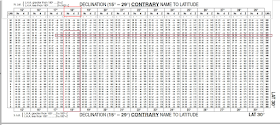Here is the exercise we will solve. It is from our Cel Nav Course, Quiz 8, #19 (CN08-0019). This is an outline of the solution. At the end is a 28 min video discussing each of the steps. You can click each of the images below for a higher res view.
Resources used can be found at starpath.com/celnavbook
We also have a book (Starpath Celestial Navigation Work Forms) that explains our forms step by step with several examples. It is effectively a short course on cel nav.
Box 1 is all from the given sight data in the question.
(For this exercise we are using the DR position given at 0300, whereas the actual sight was at 0410. In principle it would be best to DR to the time of the sight, and use that value to choose the assumed position. This is addressed at the end of the article.)
Box 2 is from daily pages of the Nautical almanac
Write these values for Hc, d and Z into Box 5. Now we need to look up the d correction
Ho is Mo it is To."
Box 2 is from daily pages of the Nautical almanac
Box 3 we get from the Increments and Corrections pages.
Now that we know GHA we can choose the assumed position (AP = a-Lat, a-Lon). Round the DR-Lat to nearest whole degree to get a-Lat, which is 30º S. Then choose the a-Lon to be the closest Lon to the DR-Lon that has the same minutes as the GHA. In this case a-Lon = 115º 7.4' W.
With these values we can then find final LHA = GHA – a-Lon, and fill Box 4 that we need for the sight reduction tables and then turn to Pub 249, Vol 2 for Lat 30, Contrary Name, Dec = 18, LHA = 322. which we find on the page below.
Our d value is -52, our dec minutes are 43.8. We note that dec min 43 has correction 37 and dec min 44 has correction 38, so we can interpolate by eye to get our correction as 37.8, which is minus and this goes into Box 5. And we find the final value of Hc = 34º 18.2', which we copy to the right side of the form, following the arrows.
Also figure Zn from Z, using the rules on the work form. These same rules appear on every page of the sight reduction tables as well. Here we are S Lat with LHA > 180, so Zn = 180 - Z. Figure that and add to the form.
Now we convert Hs to Ho on the right side of the form.
We get dip and altitude correction from the Almanac page below:
Add these to the form and sum up to get Ho.
Note that the two closest planets Venus and Mars can have an additional alt correction, which will be in the middle column. These are dependent on the year. Jupiter and Saturn do not have these.
Now subtract Hc and Ho, smaller from larger to get the a-value, and label it with the letter next to the larger of the two... or use the jingle "Calculated greater away" or "If
So the answer the question is: (a) Assumed position is 30º S, 115º 7.4' W and (b) the LOP is a = 0.9'A from 033.
______________
Two last thoughts to wrap up this exercise:
(1) The DR position given was earlier than the sight time, so in principle we should DR from 0300 to 0411 to find the right DR to use for choosing the AP. This plot is shown below:
We see that the new DR does not affect our choice of AP. This step, however, should be checked for all exercises like this one.
(2) We have a useful training tool in Stan Klein's Celestial Tools. The option called "SR Methods & Fix." This unique function shows what you should get at each intermediate step in a sight reduction depending on which method you select. Here we chose Pub 249, v2 or v3. We see below that he computes what we see in the form. Check out this neat tool as a way to verify your work... especially as you move on to using the NAO tables (he calls them NASR) or or Pub 229.
____________
To see a video of the above notes with more discussion see below (caution, it is 28 min long!)












No comments:
Post a Comment